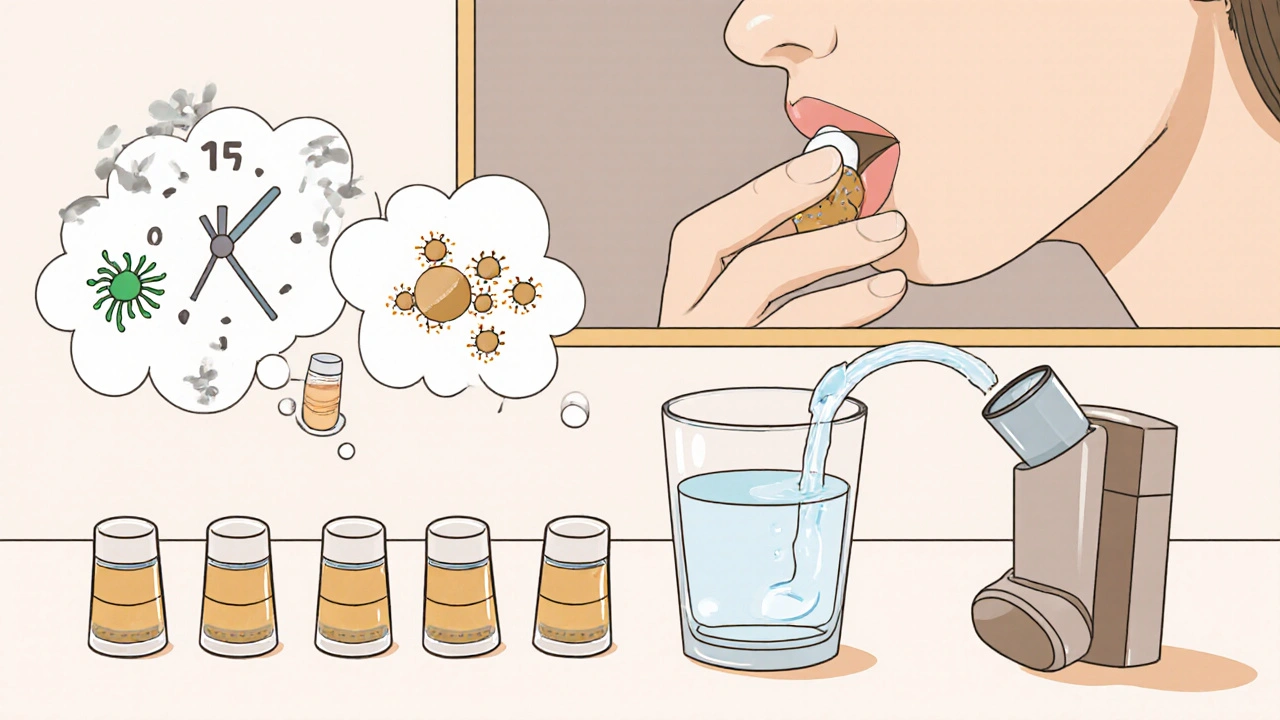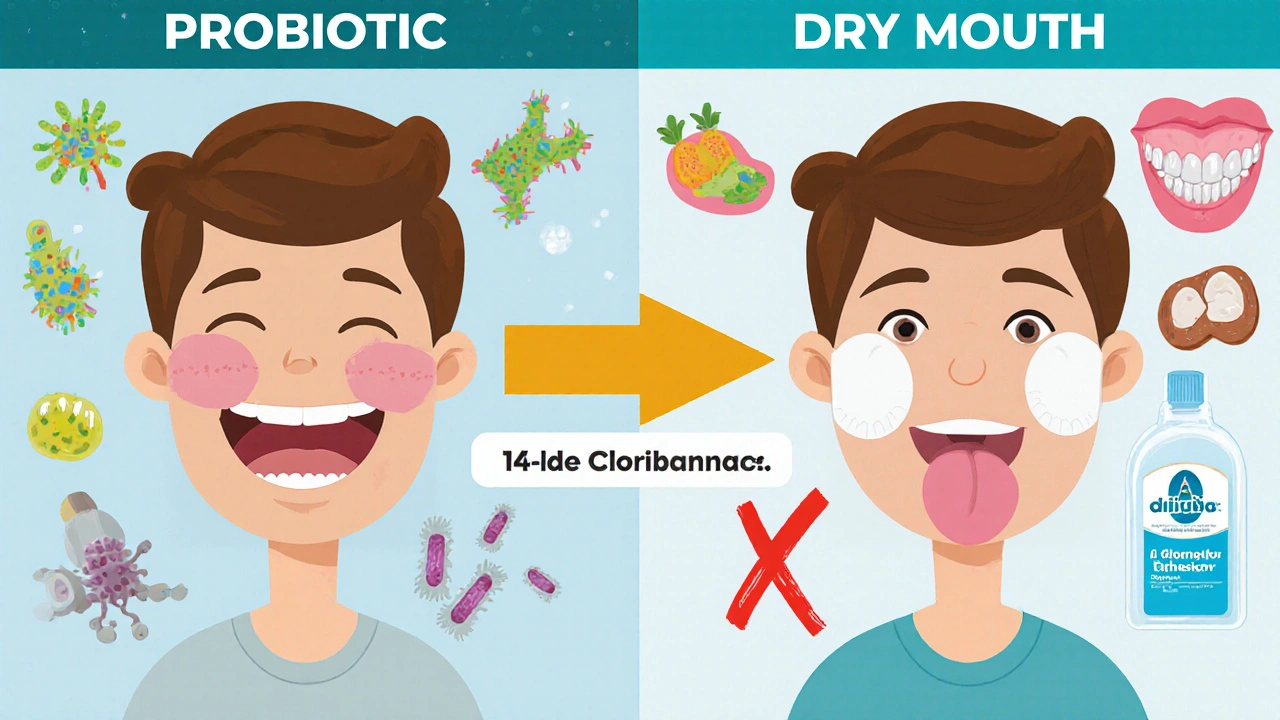Oral thrush isn’t just a nuisance-it can make eating, swallowing, and even talking painful. If you’ve noticed white patches in your mouth, a cottony feeling, or a loss of taste, you might be dealing with a fungal infection caused by Candida albicans. For many people, especially those with weakened immune systems, diabetes, or who use inhalers, clotrimazole lozenges are a simple, effective solution. But how do they actually work? And are they right for you?
What Is Oral Thrush?
Oral thrush, or oropharyngeal candidiasis, is a fungal infection that grows in the mouth and throat. It’s not contagious like a cold, but it thrives when your body’s natural balance gets disrupted. Antibiotics, inhaled corticosteroids for asthma, dry mouth, dentures, or even chemotherapy can create the perfect environment for Candida to overgrow.
The most obvious sign? Creamy white lesions on your tongue, inner cheeks, or roof of your mouth. These patches can bleed if scraped. You might also feel discomfort, a burning sensation, or notice that food tastes off. In severe cases, the infection can spread down the esophagus, making swallowing painful or difficult.
It’s common in babies, older adults, and people with HIV/AIDS or diabetes. But even healthy adults can get it after a course of antibiotics or if they’ve been on steroids. If you’ve tried rinsing with salt water and it hasn’t cleared up in a week, you likely need an antifungal treatment-like clotrimazole lozenges.
How Clotrimazole Lozenges Work
Clotrimazole is an antifungal medication that kills Candida by breaking down its cell membrane. Unlike systemic antifungals that travel through your bloodstream, clotrimazole lozenges work locally. You let the lozenge dissolve slowly in your mouth, releasing the drug directly where the infection lives.
Each lozenge contains 10 mg of clotrimazole. You’re supposed to let it dissolve over 15 to 30 minutes, moving it around your mouth occasionally to cover all affected areas. This direct delivery means higher concentrations reach the infection site without affecting your liver or kidneys like oral pills might.
It’s not a quick fix-you won’t feel better after one lozenge. But studies show most people see improvement within 3 to 5 days, with full clearance by day 14. A 2023 clinical review in the Journal of Antimicrobial Chemotherapy found clotrimazole lozenges cleared oral thrush in 87% of patients who completed the full 14-day course.
How to Use Clotrimazole Lozenges Correctly
Using these lozenges wrong can make them useless. Here’s the right way:
- Wash your hands before handling the lozenge.
- Place one lozenge in your mouth, preferably near the affected area.
- Let it dissolve slowly. Do not chew, crush, or swallow it whole.
- Move it gently around your mouth with your tongue every few minutes to spread the medication.
- Avoid eating or drinking for at least 30 minutes after it dissolves.
- Use five times a day-after meals and before bed-for 14 days, even if symptoms disappear earlier.
Missing doses or stopping early is the #1 reason treatment fails. Candida can bounce back stronger if you don’t kill all of it. Stick to the full course.
Don’t use more than five lozenges a day. Overuse can irritate your mouth lining or cause nausea. If you accidentally swallow one, it’s not dangerous-but it won’t help either, since the drug works best locally.

Who Should Not Use Clotrimazole Lozenges
Clotrimazole lozenges are generally safe, but not for everyone.
- Children under 3: The lozenge is a choking hazard. Doctors usually prescribe nystatin suspension instead.
- Allergies to clotrimazole or imidazoles: If you’ve had a rash or swelling from clotrimazole cream or other antifungals, avoid this form.
- Severe liver disease: Though it’s topical, a small amount is absorbed. Your doctor may adjust the dose or pick another option.
- Pregnant women: While studies show low risk, most doctors prefer to use nystatin in pregnancy unless clotrimazole is clearly needed.
If you’re on other medications-especially those metabolized by the liver like warfarin or statins-tell your doctor. Clotrimazole can interact, though it’s rare with lozenges.
Side Effects and What to Watch For
Most people tolerate clotrimazole lozenges well. But some mild side effects can happen:
- Bitter taste (very common)
- Nausea or upset stomach
- Itching or redness in the mouth
- Loss of appetite
These usually fade after a few days. If you develop swelling of the face, tongue, or throat, or trouble breathing, stop using it immediately. That’s a rare allergic reaction.
Some people report a temporary change in taste, which goes away after treatment ends. If your mouth feels unusually dry or sore after using the lozenges, it might be from the inactive ingredients. Try sipping water slowly after each dose.
How Clotrimazole Compares to Other Treatments
There are other options for oral thrush, but clotrimazole lozenges have clear advantages:
| Treatment | Form | Duration | Pros | Cons |
|---|---|---|---|---|
| Clotrimazole lozenges | Oral lozenge | 14 days | Targets infection directly, low systemic absorption, proven effectiveness | Must dissolve slowly, bitter taste, not for young children |
| Nystatin suspension | Oral liquid | 7-14 days | Safe for babies and pregnant women, low cost | Must swish and swallow, less effective for severe cases |
| Fluconazole tablets | Oral pill | 7-14 days | Single daily dose, good for widespread infection | Higher risk of liver interactions, more side effects |
| Miconazole oral gel | Topical gel | 7-14 days | Easy to apply, good for localized spots | Can be messy, less effective if not applied correctly |
Clotrimazole lozenges are often the first choice for adults because they’re targeted, well-tolerated, and don’t interfere with other medications as much as fluconazole does. If you’re on blood thinners or have liver issues, your doctor might skip fluconazole and go straight to the lozenge.

Preventing Oral Thrush from Coming Back
Clearing the infection is only half the battle. Without changes, thrush often returns.
- If you use a corticosteroid inhaler, rinse your mouth with water after each use-don’t just swallow.
- Keep dentures clean. Soak them overnight in a disinfecting solution and brush them daily.
- Control blood sugar if you have diabetes. High glucose levels feed Candida.
- Limit sugary foods and refined carbs. Candida thrives on sugar.
- Stay hydrated. Dry mouth = more risk.
- Consider probiotics. Some studies show that daily Lactobacillus supplements help maintain healthy mouth flora.
For people on long-term antibiotics or immunosuppressants, your doctor might recommend periodic antifungal checks. Don’t wait until symptoms return to act.
When to See a Doctor
You don’t need to see a doctor for every white spot in your mouth. But call one if:
- The white patches don’t improve after 7 days of treatment
- You have pain when swallowing or feel like food is stuck
- You have a fever, chills, or feel generally unwell
- You’re diabetic, HIV-positive, or on chemotherapy and develop thrush
- You get thrush more than twice a year
Recurrent thrush can signal an underlying condition-like undiagnosed diabetes, immune deficiency, or even certain cancers. A simple blood test or oral swab can rule these out.
Can I buy clotrimazole lozenges over the counter?
No, clotrimazole lozenges require a prescription in the U.S. and most other countries. They’re not sold as OTC like throat lozenges or antifungal creams. You’ll need to see a doctor or dentist to get them.
How long does it take for clotrimazole lozenges to work?
Most people notice less pain and fewer white patches within 3 to 5 days. But it takes the full 14-day course to fully eliminate the fungus and prevent a rebound infection. Don’t stop early, even if you feel better.
Can I use clotrimazole lozenges while pregnant?
Clotrimazole lozenges are considered low-risk in pregnancy, but doctors usually prefer nystatin first because it’s not absorbed at all. If your infection is severe or nystatin didn’t work, your doctor may still prescribe clotrimazole after weighing the benefits.
Do clotrimazole lozenges interact with other medications?
Rarely. Since very little of the drug enters your bloodstream, interactions are uncommon. But if you’re taking warfarin, statins, or certain antidepressants, tell your doctor before starting. They’ll check for any potential overlap.
What if the lozenges don’t work?
If you’ve used clotrimazole lozenges correctly for 14 days and still have symptoms, see your doctor. You might need a different antifungal like fluconazole, or your infection could be caused by a different fungus. Sometimes, an underlying condition like diabetes or HIV is the real issue.
Final Thoughts
Clotrimazole lozenges aren’t flashy, but they’re one of the most reliable tools for treating oral thrush in adults. They’re targeted, effective, and safer than pills for many people. The key is using them exactly as directed-five times a day, for the full two weeks.
Don’t ignore persistent white patches in your mouth. They’re not just a minor annoyance-they’re a sign your body’s balance is off. With the right treatment and a few lifestyle tweaks, you can clear it up and keep it from coming back.


I used these after my antibiotics and honestly? They saved my life. My tongue looked like a cheese cube, and I couldn't eat anything without crying. The bitter taste? Yeah, it's awful. But I didn't care. I let them dissolve slowly like the instructions said, and by day 5, I could taste coffee again. No joke.
Ugh, I HATE when people just say 'use it for 14 days' like it's that easy?? I stopped at day 7 because I was so done with the gross taste and my mouth felt like sandpaper. And guess what? It came back TWICE. Now I'm on my third round. Why don't doctors just give you something that doesn't taste like regret??
Clotrimazole lozenges are the quiet hero of oral health. No drama. No IVs. Just a little candy that kills fungus. I’ve used them after chemo, and honestly? Better than the liquid stuff. The bitterness? That’s just the medicine saying ‘I’m working.’
Also, rinse your inhaler. Seriously. Do it.
If you're reading this and you're worried about using clotrimazole, I get it. It feels overwhelming. But you're not alone. Many people-especially those with diabetes or on inhalers-find relief with this treatment. Just remember: consistency is everything. Five times a day, even when you're tired. Even when it tastes bad. You're not just treating a patch-you're restoring balance.
And if you're pregnant? Talk to your provider. Nystatin is often first-line, but clotrimazole is safe when needed. You've got this.
87% clearance rate per 2023 meta-analysis. Localized delivery minimizes hepatic metabolism. Recommended first-line for non-pregnant adults without contraindications. Duration must be strictly adhered to prevent resistance.
Brooklyn here from Melbourne-used these after my asthma meds wrecked my mouth. They worked. But seriously? The taste is like licking a chemistry lab. I threw one out because I thought it was a mint. Then I cried. Don’t be me.
For those managing recurrent thrush, especially with immunosuppression, clotrimazole lozenges offer targeted antifungal activity with minimal systemic exposure-critical in polypharmacy contexts. Adjunctive probiotics (L. reuteri, L. rhamnosus) show promise in mucosal colonization resistance. Don’t overlook oral hygiene protocols: denture disinfection, hydration, and sugar reduction are non-negotiables. This isn’t just treatment-it’s ecosystem restoration.
Why not just use salt water? So many people overcomplicate stuff. This is just a fungus. You don't need fancy lozenges.
OMG I just found out my friend used these and didn't tell her doctor?? That's so irresponsible!! You can't just take meds without a prescription!! I'm so mad for her!! She could've died!!